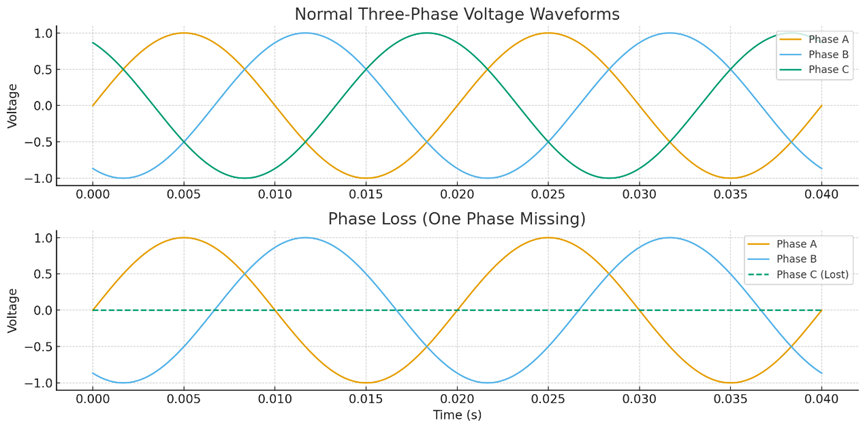Phase loss protection refers to safeguarding the power system when a phase is lost in a three-phase AC supply. In power systems and industrial production, the three-phase power supply is the most common and critical method of power delivery. It not only drives large motors but is also widely used in substations, factory workshops, conveyor systems, and other key facilities. The main advantages of three-phase power include balanced power transmission, high efficiency, and symmetrical waveforms, all of which provide equipment with stable and reliable energy.
However, real-world operations are not always smooth. Three-phase systems may experience phase loss (also called phase failure), a common yet highly destructive fault. Phase loss can cause abnormal operation of equipment, motor burnout, and even electrical fires.
A three-phase system consists of three power lines with equal voltage magnitudes and a 120° phase difference. Under normal operation, the currents and voltages remain symmetrical, resulting in a high power factor and efficient energy utilization.
Phase loss refers to:
The complete loss of voltage in one phase (e.g., due to a broken conductor or blown fuse), or
A severe voltage drop in one phase, leading to unbalanced operation.
From a physical perspective, phase loss disrupts system symmetry, causing distortion in currents and electromagnetic fields.

In ideal conditions, three-phase currents cancel each other, leaving the neutral current at zero. Once a phase is lost, current balance is destroyed, neutral current rises, torque fluctuations intensify, and equipment damage becomes highly likely.
Phase loss is frequent in electrical systems, mainly caused by:
Broken Supply Line
Distribution lines may suffer phase breaks due to mechanical damage, insulation failure, or operational errors.
Blown Fuse
In low-voltage systems, if one fuse blows while the others remain intact, the equipment will continue running under phase loss conditions.
Loose or Oxidized Terminals
In high-vibration environments, terminals may loosen or overheat due to oxidation, causing phase interruption.
Cable Insulation Aging
Long-term cable operation may result in moisture ingress or aging, leading to insulation breakdown in a single phase.
Upstream Grid Faults
Single-phase tripping or unbalanced voltages in the upstream network can also cause phase loss at the user side.
Motors are the most widespread load for three-phase power, and also the most vulnerable to phase loss.
Failure to Start
With one phase lost, the motor cannot establish a proper rotating magnetic field, resulting in insufficient starting torque. Forced starting under these conditions causes stall currents several times the rated value, leading to rapid overheating of windings.
Overcurrent During Operation
If phase loss occurs during normal operation, the motor may continue running, but the remaining two phases carry sharply increased currents:
(1). Typically 2–3 times the rated value,
(2). Causing rapid winding temperature rise and insulation damage,
(3). Prolonged operation leads to motor burnout.
Torque Reduction and Stall
Output power drops significantly under phase loss. With heavy loads, the motor may stall, further raising current and accelerating failure.
Power Quality Deterioration
Phase loss introduces imbalance into the network, causing instability in other equipment and triggering malfunctions in protective relays.
Cascading System Impact
Widespread motor phase loss aggravates current distortion, increases harmonics, degrades power quality, and may even compromise protective relay performance at upstream substations.
From a motor’s perspective, the rotating magnetic field relies on balanced three-phase currents. When one phase is missing:
The magnetic field becomes unbalanced and weaker,
Torque ripple increases,
Current waveforms distort, and temperature rises rapidly.
From a protection standpoint, phase loss is an asymmetrical fault characterized by:
Fault current much lower than a short-circuit, but highly deceptive,
Conventional fuses or overload relays may not respond promptly,
Dedicated phase loss detection devices are essential for protection.
Phase Loss Protection Relays (Phase Sequence Relays)
These devices continuously monitor the three-phase supply. If a phase disappears or a severe imbalance occurs, they immediately cut off the control circuit to prevent motor damage. Proper operation of phase sequence relays ensures reliable protection. Regular testing and maintenance are required.
Protection relay testers can simulate phase loss faults, enabling efficient inspection and maintenance.

Thermal Relays and Overload Protection
Thermal relays trip under overload but respond slowly to phase loss, making them suitable only as auxiliary protection in conjunction with phase loss relays.
Intelligent Motor Protection Relays
Widely adopted in recent years, these devices monitor current, voltage, and power factor. They protect against phase loss, overload, overvoltage, undervoltage, and ground faults, with advanced features like remote communication and alarms.
Routine Inspection and Maintenance
(1). Regularly check terminal connections for tightness,
(2). Inspect cable insulation for moisture or aging,
(3). Monitor grid voltage balance, and install power quality analyzers when necessary.
At the system level, phase loss is less dramatic than a short circuit but equally critical for protection devices:
In substations, current transformers (CTs) and relays can detect asymmetrical currents,
On low-voltage systems, phase loss relays provide rapid protection,
In automation systems, PLCs with current-sampling modules can monitor phase loss and trigger alarms.
Therefore, phase loss protection should be integrated across generation, transmission, distribution, and utilization, ensuring overall system stability.
Phase loss in three-phase systems is a common yet extremely hazardous electrical fault. Unlike short circuits, it often goes unnoticed until serious damage occurs. For motors, phase loss may cause:
Failure to start,
Current distortion and overheating,
Torque reduction and stalling,
Insulation failure or burnout.
To mitigate risks, engineers and maintenance personnel must:
Install phase loss relays or intelligent motor protection relays on critical equipment,
Configure overload and thermal relays appropriately,
Conduct routine inspections of lines, terminals, and cables,
Establish power quality monitoring and alarm mechanisms.
Only by implementing these measures can motors and electrical equipment operate safely and reliably over the long term, preventing costly damage caused by phase loss.